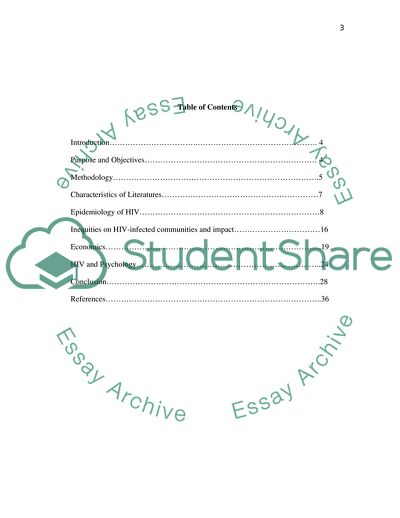
- Home
- Free Samples
- Premium Essays
- Editing Services
- Extra Tools
- Essay Writing Help
- About Us
- Studentshare
- Subjects
- Health Sciences & Medicine
- The Impact of HIV on Women in South Africa
The Impact of HIV on Women in South Africa - Literature review Example

- Subject: Health Sciences & Medicine
- Type: Literature review
- Level: Undergraduate
- Pages: 33 (8250 words)
- Downloads: 0
- Author: idaosinski
Extract of sample "The Impact of HIV on Women in South Africa"
While researcher recognizes the depressing conditions of those affected and those living with them, interventions for protected sex, education, psychosocial and trauma supports, economic assistance for resiliency, risk management, and medical help is much appreciated to prolong the lives of these people, especially the women and children. African women seem to be at the frustrating edge of this world. Although changing policies, vigorous interventions, and relatively improved economic performance have eased the labour market dynamics for women with increasing feminisation in South Africa.
However, notwithstanding women’s involvement in the labour sector, still they are overrepresented in low-income or less secure employment (Westhuizen, Goga,& Oosthuizen, 2007, p. 1). The government has not created sufficient jobs that could absorb new entrants and unemployed women in the labour market. In a qualitative report on women’s conditions from 1995 to 2005, the researcher explicated that the feminisation of the South African labour force between 1995 and 2005 was driven by the increasing involvement of women's labour force which account for more than half of the previous records (Westhuizen, et al., 2007, p. 1).
This positive development however also reflects the fact that most of those employed are unskilled and low-paid elementary workers. Women’s plight, as HIV-infected persons, is still nonetheless threatened with discrimination and gender bias, especially felt by those who are diagnosed positive for HIV infection (Westhuizen, Goga,& Oosthuizen, 2007, p. 1). This paper aims to provide a substantial literature review of the impact of HIV on women in South Africa by exploring (a) the epidemiological basis of HIV, (b) examining the socio-economic impact of the HIV-positive diagnosis on women, (c) explore the inequalities associated with HIV diagnosis, and (d) evaluate the psychological effects of living with HIV infection.
CHECK THESE SAMPLES OF The Impact of HIV on Women in South Africa
Past and Present Economical Situation of South Africa
Migration: Impacts on South Africa
The Problem of HIV and AIDS in South Africa
Africas AIDS Epidemic
Population Health in South Africa
Child Rape in South Africa
The Impact of HIV Positive Diagnosis on Women in South Africa
Oral History: Apartheid in South Africa

- TERMS & CONDITIONS
- PRIVACY POLICY
- COOKIES POLICY